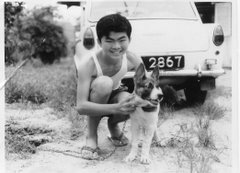Among the (year)
1952 photos that Joe Elliott sent me, are these gems of an open-air theatre
which I believe should be at Somapah Village.
This is the
external view of the theatre. The title of the movie, as far as I can make out
is “小 罗 宾 汉” (Little Robin Hood) directed
by 梁 深 (王 字 旁) starring
羽 马 and
佳 缨 .
Anyone heard of these names?
This is the
entrance “to all seats”; Adult – 50 cts, Children – 30 cts.
Seating and
screen area. The Gents is on the left of the screen.
This is the Projection
box.
This photo
shows the outside of the theatre. To the right of this photo is the open air theatre
and in front - left to right - is Changi Rd. The road straight ahead leads to
Mata Ikan.
This is Joe’s hand-drawn map of the
area.
After studying
the last photo and Joe’s sketch; and comparing it with the 1963 street directory maps of this area (below), I have come to the conclusion that this
open-air theatre was located at what was then the Somapah Village; near or at
the junction of Jalan Tiga Ratus and Upper Changi Road to be exact. The road
leading to Maka Ikan is Somapah Road.
Here is a 2007 map of this area for comparison. Parts of Somapah Road remain.
Below
are two recent photos of this area taken from Jalan Tiga Ratus. The first photo
is from Google Streetview (probably taken a couple of years ago) and the second
photo was taken by me this morning. As you can see, a great deal of construction
is going on.
In my book
Good Morning Yesterday, I gave a detail description (page 15) of the open-air
theatre that I used to go to in the 1950s. This was the South Country Theatre (南国戏院) located at, what is today, the Raffles Institution in
Bishan. Thanks to Joe’s photos, more details have come back. For example, the
location of the toilets to the right and left of the screen were just like in
Joe’s photo. I also recall, now, how we were quite fascinated by the beam of
bright light that was projected from the box office over our heads and onto the
screen.
As I did not
have a photo of the South Country Theatre, I had to search the National
Archives’ Picas data base and I managed to find this 1986 photo which I then
used in page 132 of my book. According to the description given in the Picas
website, this open-air theatre was located at Somapah Village. Could this be
the very same theatre in Joe’s photos – albeit an upgraded’ version? Your views
please.










.jpg)












+copy.jpg)
+copy.jpg)
+copy.jpg)










b+copy.jpg)
.jpg)
+Vendor+near+Bedok+Rest+House+copy.jpg)
+copy.jpg)
+copy.jpg)
+copy.jpg)
+copy.jpg)













